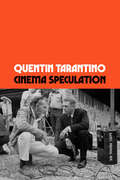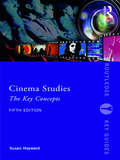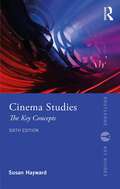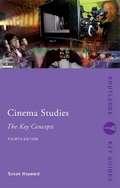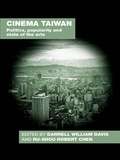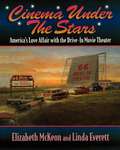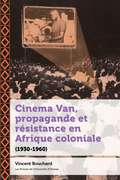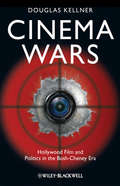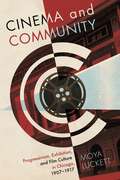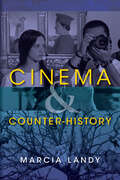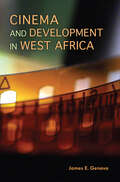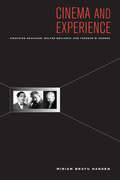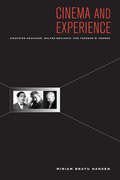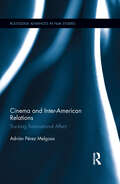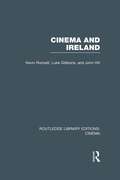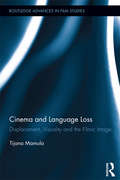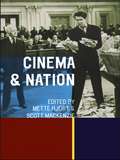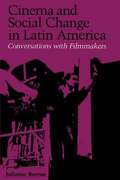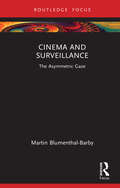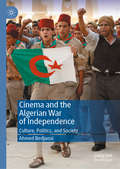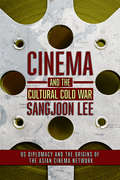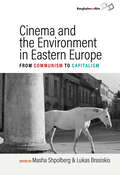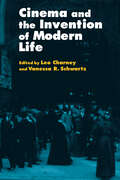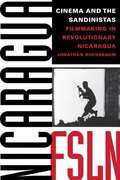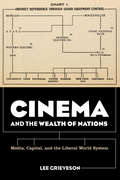- Table View
- List View
Cinema Speculation
by Quentin TarantinoInstant New York Times bestsellerThe long-awaited first work of nonfiction from the author of the #1 New York Times bestselling Once Upon a Time in Hollywood: a deliriously entertaining, wickedly intelligent cinema book as unique and creative as anything by Quentin Tarantino.In addition to being among the most celebrated of contemporary filmmakers, Quentin Tarantino is possibly the most joyously infectious movie lover alive. For years he has touted in interviews his eventual turn to writing books about films. Now, with Cinema Speculation, the time has come, and the results are everything his passionate fans—and all movie lovers—could have hoped for. Organized around key American films from the 1970s, all of which he first saw as a young moviegoer at the time, this book is as intellectually rigorous and insightful as it is rollicking and entertaining. At once film criticism, film theory, a feat of reporting, and wonderful personal history, it is all written in the singular voice recognizable immediately as QT’s and with the rare perspective about cinema possible only from one of the greatest practitioners of the artform ever.
Cinema Studies: The Key Concepts (Routledge Key Guides)
by Susan HaywardCinema Studies: The Key Concepts is essential reading for anyone interested in film. Providing accessible coverage of a comprehensive range of genres, movements, theories and production terms, this is a must-have guide to a fascinating area of study and arguably the greatest art form of modern times. Now fully revised and updated for its fifth edition, the book includes entries on topics such as: Acting Audience CGI Convergence Cult cinema Digitisation and globalization Distribution Experimental film Transnational cinema World cinemas
Cinema Studies: The Key Concepts (Routledge Key Guides)
by Susan HaywardNow in its sixth edition, this essential guide for students provides accessible definitions of a comprehensive range of genres, movements, world cinemas, theories and production terms. This fully revised and updated book includes new topical entries that explore areas such as film and the environmental crisis; streaming and new audience consumption; diversity and intersectionality; questions related to race and representation; the Black Lives Matter movement; and New Wave Cinemas of Eastern European countries. Further new entries include accented/exilic cinema, border-cinema, the oppositional gaze, sonic sound and Black westerns. Existing entries have been updated, including discussion of #MeToo, and more contemporary film examples have been added throughout. This is a must-have guide for any student starting out on this fascinating area of study and arguably the greatest art form of modern times.
Cinema Studies: The Key Concepts 4th Edition
by Susan HaywardCinema Studies: The Key Concepts is an essential guide for anyone interested in film. Providing accessible coverage of a comprehensive range of genres, movements, theories and production terms, this is a must-have guide to a fascinating area of study and arguably the greatest art form of modern times. Now fully revised and updated for its fourth edition, the book includes new topical entries such as: CGI Convergence Cult cinema Digital cinema/Post-digital cinema Dogme 95* Movement-image/Time-image Quota quickies 3-D technology
Cinema Taiwan: Politics, Popularity and State of the Arts
by Darrell William Davis Ru-Shou Robert ChenFollowing the recent success of Taiwanese film directors, such as Hou Hsiao-hsien, Edward Yang, Ang Lee and Tsai Ming-liang, Taiwanese film is raising its profile in contemporary cinema. This collection presents an exciting and ambitious foray into the cultural politics of contemporary Taiwan film that goes beyond the auterist mode, the nation-state argument and vestiges of the New Cinema. Cinema Taiwan considers the complex problems of popularity, conflicts between transnational capital and local practice, non-fiction and independent filmmaking as emerging modes of address, and new possibilities of forging vibrant film cultures embedded in national (identity) politics, gender/sexuality and community activism. Insightful and challenging, the essays in this collection will attract attention to a globally significant field of cultural production and will appeal to readers from the areas of film studies, cultural studies and Chinese culture and society.
Cinema Under the Stars: America's Love Affair with Drive-in Movie Theaters
by Elizabeth Mckeon Linda EverettWhen Richard M. Hollingshead Jr. first projected a movie onto a white bed sheet stretched between two trees at his home in Camden, New Jersey, in 1933, little did he know that he was on the verge of creating an entirely new entertainment industry. With America just beginning its romance with the automobile, it's no surprise that the general public found this new form of movie going irresistible. Fun and affordable, the drive-in quickly gained popularity among families with young children. And, of course, the local drive-in was a favorite weekend hangout for teenagers: a place where they could go just to meet friends or take a sweetheart for a romantic evening of movies under the stars. Although drive-ins are no longer as popular as they once were, in many communities a devoted following still seeks out the open-air theaters at twilight. Cinema Under the Stars" is a reminder of those wonderful times, as well as a recounting of the history of the drive-in experience. Here is the story, and here are the memories: B movies, concession stands loaded with goodies, screen towers, ticket booths, scratchy speakers, speaker poles, and intermission. It is all here - a nostalgic look at one of America's all-time favorite pastimes. "
Cinema Van, propagande et résistance en Afrique coloniale: (1930-1960) (21e – Société, histoire et cultures)
by Professeur Vincent BouchardThe “Cinema Van”, a vehicle equipped with film screening equipment, was used by the British, Belgian and French governments to distribute their “educational” films in colonial Africa in the 1940s and 1950s. The van also transported the qualified personnel, including the film commentator, who facilitated mediation with the audiences. In describing these practices as he constructs his analysis, Vincent Bouchard takes a perceptive look at the workings of this apparatus used for propaganda.Bouchard examines the influence the screenings had on the colonized African populations' understanding of the cinematic medium. What were the effects on their own systems of representation? What values were propagated by these screenings? What impact did these audiovisual recordings have on the perception, retention and transmission of experience and knowledge?Drawing on newly available archival material, this book explores the modes and practices of audience reception following their exposure to propaganda apparatus, as well as the evolution of these practices up to independence. The book examines certain forms of resistance in the face of these projections, which in some ways still continue today.Using a comparative approach, Cinema Van identifies the main cultural traits prevalent in the European administrations at the time, such as racial stereotyping and differing understandings of the cinematic medium. By compiling the information contained in activity reports, the author sketches out the discrepancy between the conception of propaganda tools and their use. Finally, he questions the modes of representation that they stage.
Cinema Wars: Hollywood Film and Politics in the Bush-Cheney Era
by Douglas M. KellnerCinema Wars explores the intersection of film, politics, and US culture and society through a bold critical analysis of the films, TV shows, and documentaries produced in the early 2000s Offers a thought-provoking depiction of Hollywood film as a contested terrain between conservative and liberal forces Films and documentaries discussed include: Black Hawk Down, The Dark Knight, Star Wars, Syriana, WALL-E, Fahrenheit 9/11 and other Michael Moore documentaries, amongst others Explores how some films in this era supported the Bush-Cheney regime, while others criticized the administration, openly or otherwise Investigates Hollywood’s treatment of a range of hot topics, from terrorism and environmental crisis to the Iraq war and the culture wars of the 2000s Shows how Hollywood film in the 2000s brought to life a vibrant array of social protest and helped create cultural conditions to elect Barack Obama
Cinema and Community: Progressivism, Exhibition, and Film Culture in Chicago, 1907-1917
by Moya LuckettCaught between the older model of short film and the emerging classic era, the transitional period of American cinema (1907-1917) has typically posed a problem for studies of early American film. Yet in Cinema and Community: Progressivism, Exhibition, and Film Culture in Chicago, 1907-1917, author Moya Luckett uses the era's dominant political ideology as a lens to better understand its cinematic practice. Luckett argues that movies were a typically Progressive institution, reflecting the period's investment in leisure, its more public lifestyle, and its fascination with celebrity. She uses Chicago, often considered the nation's most Progressive city and home to the nation's largest film audience by 1907, to explore how Progressivism shaped and influenced the address, reception, exhibition, representational strategies, regulation, and cultural status of early cinema. After a survey of Progressivism's general influences on popular culture and the film industry in particular, she examines the era's spectatorship theories in chapter 1 and then the formal characteristics of the early feature film-including the use of prologues, multiple diegesis, and oversight-in chapter 2. In chapter 3, Luckett explores the period's cinema in the light of its celebrity culture, while she examines exhibition in chapter 4. She also looks at the formation of Chicago's censorship board in November 1907 in the context of efforts by city government, social reformers, and the local press to establish community standards for cinema in chapter 5. She completes the volume by exploring race and cinema in chapter 6 and national identity and community, this time in relation to World War I, in chapter 7. As well as offering a history of an underexplored area of film history, Luckett provides a conceptual framework to help navigate some of the period's key issues. Film scholars interested in the early years of American cinema will appreciate this insightful study.
Cinema and Counter-History
by Marcia LandyDespite claims about the end of history and the death of cinema, visual media continue to contribute to our understanding of history and history-making. In this book, Marcia Landy argues that rethinking history and memory must take into account shifting conceptions of visual and aural technologies. With the assistance of thinkers such as Gilles Deleuze and Félix Guattari, Cinema and Counter-History examines writings and films that challenge prevailing notions of history in order to explore the philosophic, aesthetic, and political stakes of activating the past. Marshaling evidence across European, African, and Asian cinema, Landy engages in a counter-historical project that calls into question the certainty of visual representations and unmoors notions of a history firmly anchored in truth.
Cinema and Development in West Africa
by James E. Genova“Illuminates the enduring importance of political and economic dynamics not yet fully explored in the study of African cinema.” —AfricaCinema and Development in West Africa shows how the film industry in Francophone West African countries played an important role in executing strategies of nation building during the transition from French rule to the early postcolonial period.James E. Genova sees the construction of African identities and economic development as the major themes in the political literature and cultural production of the time. Focusing on film both as industry and aesthetic genre, he demonstrates its unique place in economic development and provides a comprehensive history of filmmaking in the region during the transition from colonies to sovereign states.
Cinema and Experience
by Edward Dimendberg Miriam Bratu HansenSiegfried Kracauer, Walter Benjamin, and Theodor W. Adorno--affiliated through friendship, professional ties, and argument--developed an astute philosophical critique of modernity in which technological media played a key role. This book explores in depth their reflections on cinema and photography from the Weimar period up to the 1960s. Miriam Bratu Hansen brings to life an impressive archive of known and, in the case of Kracauer, less known materials and reveals surprising perspectives on canonic texts, including Benjamin's artwork essay. Her lucid analysis extrapolates from these writings the contours of a theory of cinema and experience that speaks to questions being posed anew as moving image culture evolves in response to digital technology.
Cinema and Experience: Siegfried Kracauer, Walter Benjamin, and Theodor W. Adorno (Weimar and Now: German Cultural Criticism)
by Miriam HansenSiegfried Kracauer, Walter Benjamin, and Theodor W. Adorno—affiliated through friendship, professional ties, and argument—developed an astute philosophical critique of modernity in which technological media played a key role. This book explores in depth their reflections on cinema and photography from the Weimar period up to the 1960s. Miriam Bratu Hansen brings to life an impressive archive of known and, in the case of Kracauer, less known materials and reveals surprising perspectives on canonic texts, including Benjamin’s artwork essay. Her lucid analysis extrapolates from these writings the contours of a theory of cinema and experience that speaks to questions being posed anew as moving image culture evolves in response to digital technology.
Cinema and Inter-American Relations: Tracking Transnational Affect (Routledge Advances in Film Studies)
by Adrián Pérez MelgosaCinema and Inter-American Relations studies the key role that commercial narrative films have played in the articulation of the political and cultural relationship between the United States and Latin America since the onset of the Good Neighbor policy (1933). Pérez Melgosa analyzes the evolution of inter-American narratives in films from across the continent, highlights the social effects of the technologies used to produce these works, and explores the connections of cinema to successive shifts in hemispheric policy. As a result, Cinema and Inter-American Relations reveals the existence of a continued cinematic conversation between Anglo and Latin America about a cluster of shared allegories representing the continent and its cultures. Pérez Melgosa contends that cinema has become a virtual contact zone of the Americas, mediating in a variety of hemispheric political debates about the articulation of Anglo, Latin American, and Latino identities. Cinema and Inter-American Relations brings sustained attention to ongoing calls for a transnational focus on the disciplines of film studies, American studies, and Latin American studies and engages with current theories of the transmission of affect to delineate a new cartography of how to understand the Americas in relation to cinema.
Cinema and Ireland: Film, Culture And Politics (Routledge Library Editions: Cinema)
by John Hill Luke Gibbons Kevin RockettThis was the first comprehensive study of film production in Ireland from the silent period to the present day, and of representations of Ireland and ‘Irishness’ in native, British, and American films. It remains an authority on the topic. The book focuses on Irish history and politics to examine the context and significance of such films as Irish Destiny, The Quiet Man, Ryan’s Daughter, Man of Aran, Cal, The Courier, and The Dead.
Cinema and Language Loss: Displacement, Visuality and the Filmic Image (Routledge Advances in Film Studies)
by Tijana MamulaCinema and Language Loss provides the first sustained exploration of the relationship between linguistic displacement and visuality in the filmic realm, examining in depth both its formal expressions and theoretical implications. Combining insights from psychoanalysis, philosophy and film theory, the author argues that the move from one linguistic environment to another profoundly destabilizes the subject’s relation to both language and reality, resulting in the search for a substitute for language in vision itself – a reversal, as it were, of speaking into seeing. The dynamics of this shift are particularly evident in the works of many displaced filmmakers, which often manifest a conflicted interaction between language and vision, and through this question the signifying potential, and the perceptual ambiguities, of cinema itself. In tracing the encounter between cinema and language loss across a wide range of films – from Billy Wilder’s Sunset Boulevard to Chantal Akerman’s News from Home to Michael Haneke’s Caché – Mamula reevaluates the role of displacement in postwar Western film and makes an original contribution to film theory and philosophy based on a reconsideration of the place of language in our experience and understanding of cinema.
Cinema and Nation
by Mette Hjort Scott MacKenzieIdeas of national identity, nationalism and transnationalism are now a central feature of contemporary film studies, as well as primary concerns for film-makers themselves. Embracing a range of national cinemas including Scotland, Poland, France, Turkey, Indonesia, India, Germany and America, Cinema and Nation considers the ways in which film production and reception are shaped by ideas of national belonging and examines the implications of globalisation for the concept of national cinema.In the first three Parts, contributors explore sociological approaches to nationalism, challenge the established definitions of 'national cinema', and consider the ways in which states - from the old Soviet Union to contemporary Scotland - aim to create a national culture through cinema. The final two Parts address the diverse strategies involved in the production of national cinema and consider how images of the nation are used and understood by audiences both at home and abroad.
Cinema and Social Change in Latin America: Conversations with Filmmakers
by Julianne BurtonSince the late 1960s, films from Latin America have won widening audiences in North America and Europe. Until now, no single book has offered an introduction to the diverse personalities and practices that make up this important regional film movement. In Cinema and Social Change in Latin America, Julianne Burton presents twenty interviews with key figures of Latin American cinema, covering three decades and ranging from Argentina to Mexico. Interviews with pioneers Fernando Birri, Nelson Pereira dos Santos, and Glauber Rocha, renowned feature filmmakers Tomás Gutiérrez Alea and Carlos Diegues, prize-winning documentarists Patricio Guzmán and Helena Solberg-Ladd, among others, endeavor to balance personal achievement against the backdrop of historical, political, social, and economic circumstances that have influenced each director''s career. Presented also are conversations that cast light on the related activities of acting, distribution, theory, criticism, and film-based community organizing. More than their counterparts in other regions of the world, Latin American artists and intellectuals acknowledge the degree to which culture is shaped by history and politics. Since the mid-1950s, a period of rising nationalism and regional consciousness, talented young artists and activists have sought to redefine the uses of the film medium in the Latin American context. Questioning the studio and star systems of the Hollywood industrial model, these innovators have developed new forms, content, and processes of production, distribution, and reception. The specific approaches and priorities of the New Latin American Cinema are far from monolithic. They vary from realism to expressionism, from observational documentary to elaborate fictional constructs, from "imperfect cinema" to a cinema that emulates the high production values of the developed sectors, from self-reflexive to "transparent" cinematic styles, from highly industrialized modes of production to purely artisanal ones. What does not vary is the commitment to film as a vehicle for social transformation and the expression of national and regional cultural autonomy. From early alternative cinema efforts in Argentina, Brazil, and Cuba to a contemporary perspective from within the Mexican commercial industry to the emerging cinema and video production from Central America, Cinema and Social Change in Latin America offers the most comprehensive look at Latin American film available today. Since the late 1960s, films from Latin America have won widening audiences in North America and Europe. Until now, no single book has offered an introduction to the diverse personalities and practices that make up this important regional film movement. In Cinema and Social Change in Latin America, Julianne Burton presents twenty interviews with key figures of Latin American cinema, covering three decades and ranging from Argentina to Mexico. Interviews with pioneers Fernando Birri, Nelson Pereira dos Santos, and Glauber Rocha, renowned feature filmmakers Tomás Gutiérrez Alea and Carlos Diegues, prize-winning documentarists Patricio Guzmán and Helena Solberg-Ladd, among others, endeavor to balance personal achievement against the backdrop of historical, political, social, and economic circumstances that have influenced each director''s career. Presented also are conversations that cast light on the related activities of acting, distribution, theory, criticism, and film-based community organizing. More than their counterparts in other regions of the world, Latin American artists and intellectuals acknowledge the degree to which culture is shaped by history and politics. Since the mid-1950s, a period of rising nationalism and regional consciousness, talented young artists and activists have sought to redefine the uses of the film medium in the Latin American context. Questioning the studio and star systems of the Hollywood industrial model, these innovators have developed new forms, content, and processes of production, distribution, and reception. The specific approach...
Cinema and Surveillance: The Asymmetric Gaze (Routledge Focus on Film Studies)
by Martin Blumenthal-BarbyCinema and Surveillance: The Asymmetric Gaze shows how key modern filmmakers challenge and disturb the relation between film and surveillance, medium and message. Assembling readings of films by Harun Farocki, Michael Haneke, and Fritz Lang, the book considers surveillance in such different domains as urban life, religious doctrine, and law enforcement. With surveillance present in the modern world as both a technological phenomenon and a social practice, the author shows how cinema, as a visual medium, presents highly sophisticated analyses of surveillance. He suggests that “surveillance” is less an issue to be tackled from a secure spectatorial position than an experience to be rendered, an event to be dealt with. Far from offering a general model of spectatorship, the book explores how narrative moments of surveillance are complicated by specific spectatorial responses.In its intersection of well-known figures and a highly topical issue, this book will have broad appeal, especially, but not exclusively, among students and scholars in film studies, media studies, German studies, European studies, art history, and political theory.
Cinema and the Algerian War of Independence: Culture, Politics, and Society (Palgrave Studies in Arab Cinema)
by Ahmed BedjaouiThe book examines the war of images between France and Algeria. Discussing the role of the United States during the war, it covers topics such the presence of American reporters in Algeria, John F. Kennedy’s support for Algerian independence while a senator, the broadcasting of documentaries on the Algerian war on public television, and reporting in the press. Even half a century after Algerian independence, there remains a need for both film and literature on the war from both sides of the Mediterranean. This might seem surprising, particularly to media professionals, given the quantity of output on the subject, but both French and Algerian portrayals of the war remain flawed and shackled to their respective ideologies.The generation of FLN leaders recognized early on the importance of images, and established a clandestine film structure that would bring the Algerian cause to the world stage.The book offers an insightful and timely contribution not just to the field of North African studies but also to other disciplines, such as film and media studies, anthropology, history, journalism, and political science. Providing a rich source of research topics and viable ideas for film and documentary projects, it is a must-read for students, scholars and media professionals alike.
Cinema and the Cultural Cold War: US Diplomacy and the Origins of the Asian Cinema Network (The United States in the World)
by Sangjoon LeeCinema and the Cultural Cold War explores the ways in which postwar Asian cinema was shaped by transnational collaborations and competitions between newly independent and colonial states at the height of Cold War politics. Sangjoon Lee adopts a simultaneously global and regional approach when analyzing the region's film cultures and industries. New economic conditions in the Asian region and shared postwar experiences among the early cinema entrepreneurs were influenced by Cold War politics, US cultural diplomacy, and intensified cultural flows during the 1950s and 1960s. By taking a closer look at the cultural realities of this tumultuous period, Lee comprehensively reconstructs Asian film history in light of the international relationships forged, broken, and re-established as the influence of the non-aligned movement grew across the Cold War.Lee elucidates how motion picture executives, creative personnel, policy makers, and intellectuals in East and Southeast Asia aspired to industrialize their Hollywood-inspired system in order to expand the market and raise the competitiveness of their cultural products. They did this by forming the Federation of Motion Picture Producers in Asia, co-hosting the Asian Film Festival, and co-producing films. Cinema and the Cultural Cold War demonstrates that the emergence of the first intensive postwar film producers' network in Asia was, in large part, the offspring of Cold War cultural politics and the product of American hegemony.Film festivals that took place in cities as diverse as Tokyo, Singapore, Hong Kong, and Kuala Lumpur were annual showcases of cinematic talent as well as opportunities for the Central Intelligence Agency to establish and maintain cultural, political, and institutional linkages between the United States and Asia during the Cold War. Cinema and the Cultural Cold War reanimates this almost-forgotten history of cinema and the film industry in Asia.
Cinema and the Environment in Eastern Europe: From Communism to Capitalism
by Masha Shpolberg and Lukas BrasiskisThe annexation of Eastern Europe to the Soviet sphere after World War II dramatically reshaped popular understandings of the natural environment. With an eco-critical approach, Cinema and the Environment in Eastern Europe breaks new ground in documenting how filmmakers increasingly saw cinema as a tool to critique the social and environmental damage of large-scale projects from socialist regimes and newly forming capitalist presences. New and established scholars with backgrounds across Europe, the United States, and Australia come together to reflect on how the cultural sphere has, and can still, play a role in redefining our relationship to nature.
Cinema and the Invention of Modern Life
by Leo Charney Vanessa R. SchwartzCasting aside the traditional conception of film as an outgrowth of photography, theater, and the novel, the essays in this volume reassess the relationship between the emergence of film and the broader culture of modernity. Contributors, leading scholars in film and cultural studies, link the popularity of cinema in the late nineteenth century to emerging cultural phenomena such as window shopping, mail-order catalogs, and wax museums.
Cinema and the Sandinistas: Filmmaking in Revolutionary Nicaragua
by Jonathan BuchsbaumUsing a wealth of firsthand documentation—the films themselves, interviews with numerous INCINE personnel, and INCINE archival records—Jonathan Buchsbaum follows the evolution of INCINE's project and situates it within the larger historical project of militant, revolutionary filmmaking in Latin America. His research also raises crucial questions about the viability of national cinemas in the face of accelerating globalization and technological changes which reverberate far beyond Nicaragua's experiment in revolutionary filmmaking.
Cinema and the Wealth of Nations: Media, Capital, and the Liberal World System
by Lee GrievesonCinema and the Wealth of Nations explores how media, principally in the form of cinema, was used during the interwar years by elite institutions to establish and sustain forms of liberal political economy beneficial to their interests. It examines the media produced by institutions such as states, corporations, and investment banks, as well as the emergence of a corporate media industry and system supported by state policy and integral to the establishment of a new consumer system. Lee Grieveson shows how media was used to encode liberal political and economic power during the period that saw the United States eclipse Britain as the globally hegemonic nation and the related inauguration of new forms of liberal economic globalization. But this is not a distant history. Cinema and the Wealth of Nations examines a foundational conjuncture in the establishment of media forms and a media system instrumental in, and structural to, the emergence and expansion of a world system that has been—and continues to be—brutally violent, unequal, and destructive.
